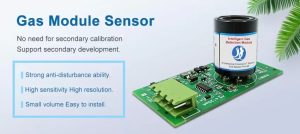Introduction With the rapid urbanization and industrialization, air pollution has become a major concern for cities around the world. Poor air quality not only affects the health of the residents but also has a detrimental impact on the environment. In recent years, there has been a growing emphasis on the development of smart cities, which leverage technology to improve the quality of urban life. One of the key areas of focus in smart city development is the advancement of urban air quality monitoring using gas sensors. In this article, we will explore the role of gas sensors in improving air quality in urban environments and the potential benefits they offer for smart city development.

The Importance of Urban Air Quality Monitoring Urban air quality monitoring is crucial for assessing the level of air pollution in cities and identifying sources of pollution. Poor air quality can lead to a range of health problems, including respiratory diseases, cardiovascular diseases, and even premature death. In addition, air pollution can have a significant impact on the environment, contributing to climate change, acid rain, and the deterioration of ecosystems. By monitoring air quality, city authorities can make informed decisions to mitigate pollution and protect public health and the environment.
Challenges in Urban Air Quality Monitoring Traditional air quality monitoring systems rely on a network of stationary monitoring stations, which are limited in their ability to provide real-time data on air pollution levels across a city. These systems are also costly to install and maintain, making it difficult for cities to establish comprehensive monitoring networks. Furthermore, traditional monitoring systems often lack the capability to detect specific pollutants and their sources, which hinders the development of targeted pollution control measures.
Advancing Urban Air Quality Monitoring with Gas Sensors Gas sensors offer a promising solution to the challenges of urban air quality monitoring. These sensors are capable of detecting a wide range of air pollutants, including nitrogen dioxide, carbon monoxide, sulfur dioxide, and particulate matter. They can be deployed in a variety of settings, including stationary monitoring stations, mobile monitoring platforms, and even wearable devices. Gas sensors also have the potential to provide real-time data on air pollution levels, enabling city authorities to respond quickly to pollution events and implement targeted interventions.
In recent years, there has been significant progress in the development of gas sensor technology, leading to the creation of low-cost, compact, and highly sensitive sensors. These advancements have made it possible to deploy large-scale sensor networks across cities, providing comprehensive coverage of air pollution hotspots and enabling the collection of high-resolution data on pollutant levels. Gas sensors can also be integrated with other smart city technologies, such as data analytics and communication systems, to create a connected and intelligent air quality monitoring infrastructure.
Benefits of Gas Sensor-Based Air Quality Monitoring for Smart Cities The integration of gas sensor-based air quality monitoring into smart city development offers a range of benefits for urban environments. Firstly, it enables city authorities to gain a deeper understanding of air pollution patterns and sources, allowing for the development of targeted pollution control strategies. By identifying pollution hotspots and sources, cities can implement measures to reduce emissions and improve air quality in specific areas. Gas sensor data can also be used to assess the effectiveness of pollution control measures and inform future policy decisions.
Gas sensor-based air quality monitoring also has the potential to engage citizens in environmental protection efforts. By providing real-time air quality data to the public, cities can raise awareness about the impact of air pollution on health and the environment, empowering residents to take action to reduce their exposure to pollutants. This can lead to greater public support for pollution control measures and encourage behavioral changes that contribute to improved air quality.

Furthermore, gas sensor data can be integrated with other smart city systems, such as traffic management and urban planning, to create a more holistic approach to urban environmental management. For example, air quality data can be used to optimize traffic flow and reduce congestion in areas with high pollution levels, leading to improved air quality and reduced emissions. Gas sensor data can also inform the design of green spaces and urban infrastructure to mitigate the impact of air pollution on residents and the environment.
Conclusion Gas sensor-based air quality monitoring has the potential to revolutionize the way cities monitor and manage air pollution, offering a cost-effective, scalable, and real-time solution for urban enviro
 : +86 155 8830 2704
: +86 155 8830 2704 : jxdziot@gmail.com
: jxdziot@gmail.com
